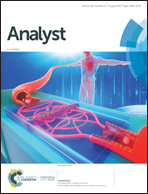Imaging analysis of EGFR mutated cancer cells using peptide nucleic acid (PNA)–DNA probes
Abstract
Lung cancer cells harbor various gene mutations in the mRNA sequence of the Epidermal Growth Factor Receptor (EGFR), especially the mutations of exon19del E746-A750, T790M, and L858R. This results in cancer progression and resistance to anticancer drugs (tyrosine kinase inhibitor; TKI). Therefore, the imaging analysis of EGFR mutations is required for the treatment planning for non-small cell lung cancers. This study focused on the imaging analysis of a single nucleotide substitute in EGFR mutated cancer cells. We developed three novel peptide nucleic acid (PNA)–DNA probes for recognizing and detecting the following three gene mutations in EGFR gene mutations. The PNA–DNA probes consist of fluorescein isothiocyanate (FITC) conjugated PNA as a detection probe and Dabcyl conjugated DNA as a quencher probe. The PNA–DNA probes were used to validate the feasibility for detecting three EGFR mutated sequences: exon19del E746-A750, T790M, and L858R. The three probes emitted fluorescent dose-dependent signals against three target DNA and RNA. Using the three PNA–DNA probes, we succeeded in distinguishing three kinds of lung-cancer cell lines (H1975, PC-9, and A549) which have different EGFR mutations by the fluorescence in situ hybridization (FISH) method.



 Please wait while we load your content...
Please wait while we load your content...
